|

Hamilton Marine, the "largest ship's chandlery north of Boston", in Portland.
Note the icicles hanging off the lower overhang pushing 6 foot long.
Return

Sargent's Custom Boats, January 11th, 2003.
The piles of snow at left are nearly as high as Joe's F-350 and my Ram 2500 pickups.
The "office", which doubles as an ice house for fishing in the winter, sits in front.
Return
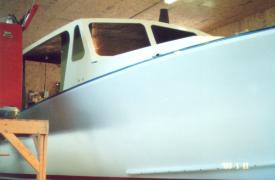
My first look each trip, the starboard bow. Here you can see the spray rail, the boot stripe and the cut out for the walk-around. Just inside the cut out you can see one of the divinycell panels in place for the sides of the wheelhouse. Joe started the panel inboard and we kept cutting it down to move it outboard until I was satisfied with its location. Sitting atop the wheelhouse you can see the engine air filter.
Return

Here is the port side, looking aft. Once again you can see the spray rail and boot stripe, along with the quarter guard towards the back. Joe hasn't yet cut out this side of the wheelhouse until we got the other side the way I wanted. This picture also gives a great idea of the exceptional freeboard of the RP 35.
Return
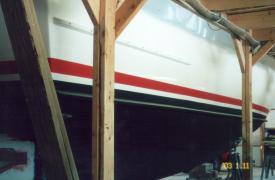
The starboard quarter.
I am standing under the platform Joe has around the inside of his shop (which sure beats the ladder a lot of shops utilize for climbing in and out of boats), looking forward.
Here you can see the quarter guard, lifting rail, boot stripe and coppered bottom.
Return
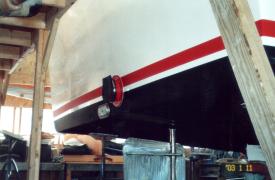
The transom, with wet exhaust and flapper. The hull bonding zinc is also visible. Another good idea of the incredible freeboard, also.
Return

The rudder is installed, along with the 2" shaft and shaft log. This also gives a pretty good idea of how flat she is in the stern, as well as the depth of her full keel.
Return

Joe is cutting the companionway in the main bulkhead.
You can see various electronics lined up on the gunwale.
Return

The view from inside the cabin, looking aft.
You can see the supports that were put in place to support the main bulkhead and dash until they are glassed in place.
Return

The forward crash bulkhead is cut to fit.
Note the separate panel to divide the resulting rope locker.
The string attached to the top of the divider was used to get it plumb.
At the lower left and lower right corners you can also see where the spray rails have been through bolted, cut down, and glassed over.
Return
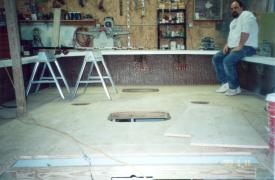
This is the deck, looking aft.
The engine hatch is in the foreground.
On the centerline will be two watertight bomar hatches for access to the intake seacock and fuel tank selector valves (mid deck) with access to the lazarette compartment and steering rams at rear.
Fuel tank access hatches have also been cut in the deck.
I brought a few of boat poles up as well to make sure there was a place for everything.
Return
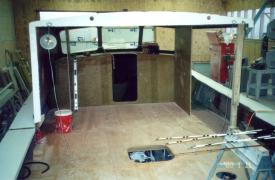
Here is a good look at where the wheelhouse will be, with the first panels in place for the port and starboard sides.
You can see the back of the gear (transmission) through the hatch, and the engine sits completely flush under the floor.
The hose at left is the fuel tank vent line.
Return
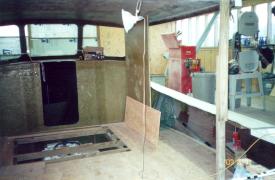
This view shows the engine hatch panels taken up.
You can see the tremendous amount of room on either side of the engine (more to the port side as this is where all the service points are).
The cross beams are all removeable over the engine, and the hatch is large enough to haul the entire engine without cutting the deck.
At right you can see on of my landing nets...a place for everything and everything in its place!
Return
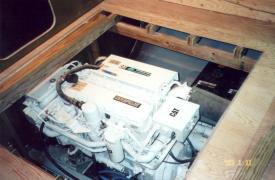
420 HP 3126 Caterpillar diesel.
You can see the LARGE engine beds with vibration dampener at lower left, along with the oil sump line (blue hose).
A pair of 8D batteries are on the far side of the engine.
There is plenty of room to have the engine pulled without cutting up the decks.
Return

The Twin Disc 5061A, 7-degree down angle, 2:1 reduction gear, is rated for 465 HP.
Note the specifications plate has the "Caterpillar" name on it, and Caterpillar can do any and all service work on the gear.
One of the bilge pump hoses is at lower right.
Return
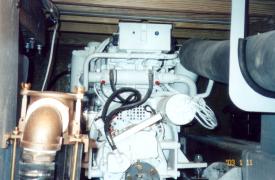
Here is the back of the engine.
The starter is super easy to access; the red dots are zincs (these are specifically for the gear cooler).
There is another good look at the engine beds at right.
Return
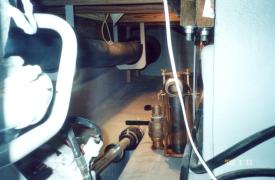
This is the view when laying along the port side of the engine looking aft.
The intake strainer is straight ahead and the 6" exhaust disappears through the lazarette bulkhead.
You can also see the dripless shaft seal to the left of the intake seacock.
Return
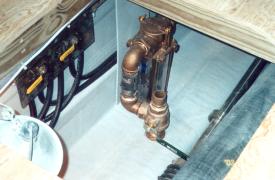
This hatch, just behind the wheelhouse, provides easy access to the fuel tank selector valves and the intake seacock.
I had the intake plumbed with a 3-way ball valve.
A hose will be run down in the bilge and should I ever have a severe problem taking on water, I can quickly switch the valve and use the engine as an emergency de-watering pump.
Joe had this hatch originally cut as 24" square, but we decided to move the back wall of the wheelhouse back a bit and this turned into a 15" x 24" hatch.
Return
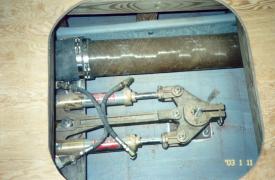
This is the lazarette compartment, home of the Hydro-Slave Class II dual-ram steering system.
This arrangement is preferable over a single ram system as the rams don't have to apply sideways pressure to the rudder.
Only the last few feet of the exhaust is solid, with the rest being flexible which allows for less stressing due to vibration.
Return
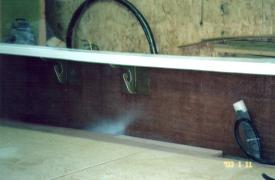
Here's a look at her under the gunwales.
Joe molded in some nice holders for gaffs, brushes or whatever.
The fuel fill and vent lines are at right, and will eventually be enclosed by vent boxes.
Return
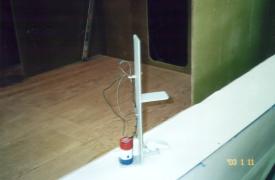
Montelle put together this nifty contraption to drop into the bilge.
The bilge pump itself is at left, with the switch sitting just above it to the right.
The platform higher up is where the bilge hi-water alarm sensor will go.
|























